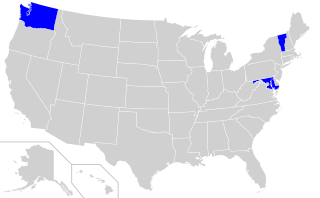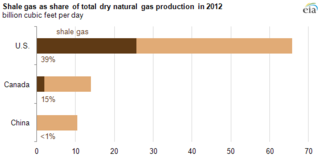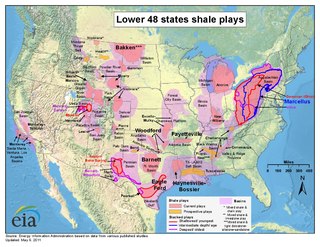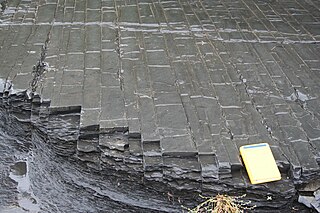Related Research Articles

Ovintiv Inc. is an American independent petroleum company. The company was formed in 2020 through a restructuring of its Canadian predecessor, Encana. Ovintiv is incorporated in Delaware and headquartered in Denver, Colorado.

Fracking in the United States began in 1949. According to the Department of Energy (DOE), by 2013 at least two million oil and gas wells in the US had been hydraulically fractured, and that of new wells being drilled, up to 95% are hydraulically fractured. The output from these wells makes up 43% of the oil production and 67% of the natural gas production in the United States. Environmental safety and health concerns about hydraulic fracturing emerged in the 1980s, and are still being debated at the state and federal levels.

Shale gas is an unconventional natural gas that is found trapped within shale formations. Since the 1990s a combination of horizontal drilling and hydraulic fracturing has made large volumes of shale gas more economical to produce, and some analysts expect that shale gas will greatly expand worldwide energy supply.

The Bakken Formation is a rock unit from the Late Devonian to Early Mississippian age occupying about 200,000 square miles (520,000 km2) of the subsurface of the Williston Basin, underlying parts of Montana, North Dakota, Saskatchewan and Manitoba. The formation was initially described by geologist J. W. Nordquist in 1953. The formation is entirely in the subsurface, and has no surface outcrop. It is named after Henry O. Bakken (1901–1982), a farmer in Tioga, North Dakota, who owned the land where the formation was initially discovered while drilling for oil.

The Monterey Formation is an extensive Miocene oil-rich geological sedimentary formation in California, with outcrops of the formation in parts of the California Coast Ranges, Peninsular Ranges, and on some of California's off-shore islands. The type locality is near the city of Monterey, California. The Monterey Formation is the major source-rock for 37 to 38 billion barrels of oil in conventional traps such as sandstones. This is most of California's known oil resources. The Monterey has been extensively investigated and mapped for petroleum potential, and is of major importance for understanding the complex geological history of California. Its rocks are mostly highly siliceous strata that vary greatly in composition, stratigraphy, and tectono-stratigraphic history.

Shale gas in the United States is an available source of unconventional natural gas. Led by new applications of hydraulic fracturing technology and horizontal drilling, development of new sources of shale gas has offset declines in production from conventional gas reservoirs, and has led to major increases in reserves of U.S. natural gas. Largely due to shale gas discoveries, estimated reserves of natural gas in the United States in 2008 were 35% higher than in 2006.

The Utica Shale is a stratigraphical unit of Upper Ordovician age in the Appalachian Basin. It underlies much of the northeastern United States and adjacent parts of Canada.

The inclusion of unconventional shale gas with conventional gas reserves has caused a sharp increase in estimated recoverable natural gas in Canada. Until the 1990s success of hydraulic fracturing in the Barnett Shales of north Texas, shale gas was classed as "unconventional reserves" and was considered too expensive to recover. There are a number of prospective shale gas deposits in various stages of exploration and exploitation across the country, from British Columbia to Nova Scotia.

Tight oil is light crude oil contained in unconventional petroleum-bearing formations of low permeability, often shale or tight sandstone. Economic production from tight oil formations requires the same hydraulic fracturing and often uses the same horizontal well technology used in the production of shale gas. While sometimes called "shale oil", tight oil should not be confused with oil shale or shale oil. Therefore, the International Energy Agency recommends using the term "light tight oil" for oil produced from shales or other very low permeability formations, while the World Energy Resources 2013 report by the World Energy Council uses the terms "tight oil" and "shale-hosted oil".

Fracking is a well stimulation technique involving the fracturing of formations in bedrock by a pressurized liquid. The process involves the high-pressure injection of "fracking fluid" into a wellbore to create cracks in the deep-rock formations through which natural gas, petroleum, and brine will flow more freely. When the hydraulic pressure is removed from the well, small grains of hydraulic fracturing proppants hold the fractures open.
Shale gas is an unconventional natural gas produced from shale, a type of sedimentary rock. Shale gas has become an increasingly important source of natural gas in the United States over the past decade, and interest has spread to potential gas shales in Canada, Europe, Asia, and Australia. One analyst expects shale gas to supply as much as half the natural gas production in North America by 2020.
MGM Energy Corp. is a Canadian petroleum company that was spun off from Paramount Resources in 2007. The company is involved in the acquisition and development of petroleum in Canada's Northwest Territories. The CEO is Henry Sykes. In October 2013 Sykes complained that the requirement to conduct environmental assessments was impeding Canadian companies, compared with their US competitors, when his firm was seeking permission to engage in hydraulic fracking in the environmentally sensitive Canol shale play region—even though the first fracking well were drilled without any environmental assessment at all.

Fracking in the United Kingdom started in the late 1970s with fracturing of the conventional oil and gas fields near the North Sea. It was used in about 200 British onshore oil and gas wells from the early 1980s. The technique attracted attention after licences use were awarded for onshore shale gas exploration in 2008. The topic received considerable public debate on environmental grounds, with a 2019 high court ruling ultimately banning the process. The two remaining high-volume fracturing wells were supposed to be plugged and decommissioned in 2022.

Fracking has become a contentious environmental and health issue with Tunisia and France banning the practice and a de facto moratorium in place in Quebec (Canada), and some of the states of the US.

Environmental impact of fracking in the United States has been an issue of public concern, and includes the contamination of ground and surface water, methane emissions, air pollution, migration of gases and fracking chemicals and radionuclides to the surface, the potential mishandling of solid waste, drill cuttings, increased seismicity and associated effects on human and ecosystem health. Research has determined that human health is affected. A number of instances with groundwater contamination have been documented due to well casing failures and illegal disposal practices, including confirmation of chemical, physical, and psychosocial hazards such as pregnancy and birth outcomes, migraine headaches, chronic rhinosinusitis, severe fatigue, asthma exacerbations, and psychological stress. While opponents of water safety regulation claim fracking has never caused any drinking water contamination, adherence to regulation and safety procedures is required to avoid further negative impacts.

The environmental impact of fracking is related to land use and water consumption, air emissions, including methane emissions, brine and fracturing fluid leakage, water contamination, noise pollution, and health. Water and air pollution are the biggest risks to human health from fracking. Research has determined that fracking negatively affects human health and drives climate change.
Shale gas in the United Kingdom has attracted increasing attention since 2007, when unconventional onshore shale gas production was proposed. The first shale gas well in England was drilled in 1875. As of 2013 a number of wells had been drilled, and favourable tax treatment had been offered to shale gas producers.

Fracking in South Africa is an energy production strategy at early stages of development using high-pressure drilling techniques to release natural gas trapped in shale rock. After initially imposing a moratorium on fracking in April 2011, the South African government lifted the moratorium in September 2012 after an initial investigation by an interdepartmental task team. Several energy companies were subsequently granted exploration licenses. Fracking in South Africa is a current topic of debate, with proponents pointing to substantial economic and energy benefits and opponents voicing concerns about potentially adverse environmental impacts.

Countries using or considering to use fracking have implemented different regulations, including developing federal and regional legislation, and local zoning limitations. In 2011, after public pressure France became the first nation to ban hydraulic fracturing, based on the precautionary principle as well as the principal of preventive and corrective action of environmental hazards. The ban was upheld by an October 2013 ruling of the Constitutional Council. Some other countries have placed a temporary moratorium on the practice. Countries like the United Kingdom and South Africa, have lifted their bans, choosing to focus on regulation instead of outright prohibition. Germany has announced draft regulations that would allow using hydraulic fracturing for the exploitation of shale gas deposits with the exception of wetland areas.

Fracking in Canada was first used in Alberta in 1953 to extract hydrocarbons from the giant Pembina oil field, the biggest conventional oil field in Alberta, which would have produced very little oil without fracturing. Since then, over 170,000 oil and gas wells have been fractured in Western Canada. Fracking is a process that stimulates natural gas or oil in wellbores to flow more easily by subjecting hydrocarbon reservoirs to pressure through the injection of fluids or gas at depth causing the rock to fracture or to widen existing cracks.
References
- ↑ Darren Campbell (May 2013). "Could the N.W.T.'s Canol shale be the next Bakken?". Alberta Oil magazine. Archived from the original on 2013-06-11. Retrieved 2014-08-18.
These days Hogg should be having a lot of fun. MGM Energy – a small Calgary-based junior – is part of a group of companies leading the charge to open up the N.W.T's Canol shale oil play. No one is sure just how much oil might be trapped in the dense rock that lines the remote central Mackenzie Valley where the play is located, but its potential conjures up images of North Dakota's Bakken, which was producing over 700,000 barrels of oil per day in 2012.
- ↑ Jack Danylchuk (2013-09-30). "Canol play sees new competitor on the Mackenzie by". Northern Journal. Archived from the original on 2013-10-29. Retrieved 2014-08-18.
The Canol Shale play was one of many potential business opportunities which was part of our decision making," Gram said, but emphasized the company's "general strategy is based more on trying to satisfy local markets. If some of these bigger plays came to fruition, we will be in position if there was a fit for ITB.
- 1 2 Jack Danylchuk (2014-01-06). "Sahtu fracking opponents calling for a region-wide vote". Northern Journal. Archived from the original on 2014-08-18.
Opponents to hydraulic fracturing in the Sahtu want residents to have the last word on the controversial process and the future of the Canol shale play.
- 1 2 Derek Leahy (2014-02-27). "NWT Residents Demand Environmental Reviews Before Fracking Is Permitted". Desmog . Retrieved 2014-02-27.
Residents of the Northwest Territories are demanding environmental reviews be conducted before companies are permitted to 'frack' for oil in the NWT. Despite controversy in Canada and other countries around the effects fracking or hydraulic fracturing has on water and climate change, the NWT's first fracking project was approved last October without an environmental assessment.
- ↑ Jeffrey Jones (2013-10-06). "NWT's shale hopes dimmed by slow approvals, explorer says". The Globe and Mail . Retrieved 2017-08-22.
MGM Energy Corp. chief executive officer Henry Sykes said regulatory hurdles are the main reason he believes that production growth in the Northwest Territories' Canol shale play in the Central Mackenzie Valley will not mirror the industry's success in the prolific Bakken oil fields of North Dakota.
- ↑ Carrie Tait (2013-01-30). "ConocoPhillips wins first regulatory approval of fracking in the North". The Globe and Mail . Retrieved 2017-08-22.
The National Energy Board gave ConocoPhillips Co. the right to drill two wells and then use horizontal fracturing, known as fracking, methods to extract oil out of shale rocks. This is the first time the NEB has authorized a company to frack in the North.
- ↑ Jeffrey Jones, Carrie Tait (2014-01-17). "Fracking and climate change: Canada's Far North gets an energy boost". The Globe and Mail . Retrieved 2017-08-22.
The global oil and gas company is preparing to employ horizontal drilling and hydraulic fracturing technology on wells in the Canol shale oil play in the Central Mackenzie Valley in February.